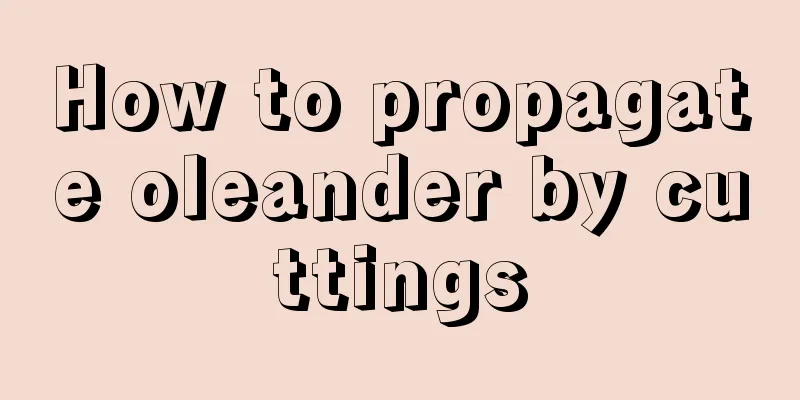How to propagate oleander by cuttings

Time for cuttingsCuttings can be taken in both spring and summer. Selection of seedbedTry to choose land that is sheltered from the wind, facing the sun, without water accumulation, free from pests and diseases, free from weeds, with sufficient fertility and easy to manage as the seedbed. When the soil is heavy, you can add appropriate amount of sand and pay attention to disinfection. Selection of cuttingsOn the same plant, it is generally recommended to choose branches from the upper and middle parts of the current year that face the sun and have thick branches and leaves. On the same branch, generally choose the middle and lower branches, the cut should be smooth, the upper end is cut into a horizontal plane, and the lower end is cut into an oblique surface. The length of the cuttings is about 15-20 cm. The cuttings must have two or three buds. The upper cut should be about 1.5 cm away from the buds, and the lower leaves should be removed. Treatment of cuttingsDo it as soon as you collect the cuttings, cut them short and plant them in cuttings. To increase the rooting rate, you can soak it in rooting powder for 2-8 hours. Cutting FangfaWhen cutting, pay attention to the upper and lower ends of the cuttings and do not insert them upside down. The cut of the cuttings must be tightly connected to the soil to prevent the cortex under the cut of the cuttings from being scratched. The depth of cuttings should generally be such that one or two buds are exposed above the ground. Mark and record them after cutting. Management after cuttingtemperatureThe optimum temperature for rooting of cuttings is 20℃ ~ 30℃. Below 20℃, rooting of cuttings is difficult and slow; above 30℃, the upper and lower cut ends of cuttings are easily infected by pathogens and rot, and the higher the temperature, the greater the proportion of rot. When encountering low temperature after cutting The main insulation measure is to wrap the flower pots or containers used for cuttings with film; when the temperature is too high after cuttings, the main cooling measure is to shade the cuttings, blocking 50-80% of the sunlight. At the same time, spray the cuttings 3-5 times a day. On sunny days with higher temperatures, the number of sprayings is more, and on rainy days with lower temperatures and higher temperatures, the number of sprayings is less or no spraying. humidityAfter cuttings, the relative humidity of the air must be maintained at 75-85%. The basic requirement for rooting cuttings is that before the cuttings take root, they must be fresh and tender and able to carry out photosynthesis to produce rooting substances. However, unrooted cuttings cannot absorb enough water to maintain the water balance in their bodies. Therefore, spraying must be used to reduce water evaporation of the cuttings: Under shaded conditions, spray the cuttings 3 to 5 times a day. The higher the temperature on sunny days, the more times you spray. The lower the temperature on rainy days, the less times you spray or no spraying. However, if you spray too much, the cuttings will easily be infected by pathogens and rot, because many types of pathogens exist in water. illuminationCutting propagation cannot be separated from sunlight, because the cuttings must continue to carry out photosynthesis to produce nutrients and rooting substances to meet their rooting needs. However, the stronger the light, the higher the temperature inside the cuttings, the more vigorous the transpiration of the cuttings, and the more water is consumed, which is not conducive to the survival of the cuttings. Therefore, after cuttings, 50-80% of the sunlight must be blocked. After the roots grow out, the shading net can be gradually removed: on sunny days, remove the shading net at 4:00 p.m. every day, and cover it before 9:00 am the next day. |
<<: How to propagate peony by cuttings
>>: How to safely overwinter colorful taro (colorful taro)
Recommend
Reasons why watermelon flowers but does not bear fruit
Every year when the watermelon season comes, some...
Can I water the cactus after I plant it?
1. Can I water the cactus after it is planted? Th...
Is persimmon a fruit or a vegetable?
Is persimmon a fruit or a vegetable? Small tomato...
Does Chinese evergreen protect against radiation?
Is it radiation proof? Not radiation proof. If yo...
Can Dieffenbachia be hydroponically cultivated? Hydroponic cultivation method
Can Dieffenbachia be hydroponically cultivated? V...
Don't place the Aspidistra casually. Whether it brings wealth or disperses it, there are some things to pay attention to!
Feng Shui meaning We all know that in Feng Shui, ...
When is the best time to prune red leaf plums?
Pruning of red leaf plum Pruning red-leaf plum tr...
Balcony cucumber planting method
Planting time The planting time for cucumbers is ...
What kind of flowerpot looks good for Golden Edge Tiger Pilan
What flowerpot is suitable for Golden Edge Tiger ...
50 common foliage plants illustrations, the most comprehensive in history
ivy Pothos Chlorophytum Wedding Chlorophytum Prun...
How to propagate hydrangea by cuttings?
Hydrangea , also known as hydrangea or hydrangea,...
Jasmine repotting and soil changing methods and precautions Jasmine repotting time and soil
Before repotting jasmine, make sure to water it t...
The leaves of the spider plant are yellow and the tips are dry? Water these two kinds of water, and the leaves of the spider plant will be green in 15 days
Chlorophytum has an irreplaceable position in peo...
Difference between Oxalis and Oxalis
1. Differences in plants: Some of the stems of Ox...
How many days will it take for the plant to recover after being wilted after being repotted?
Repotting is a common operation in plant care, wh...









